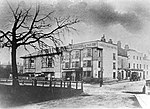Perceval House
Perceval House is a building in Blackheath, London which gave its name to a military training school; in October 1863, the school's football team became a founder-member of The Football Association, the body which regulates football in England.The school's representative on the inaugural meeting of the Football Association was G.W. Shillingford. He, along with his colleagues from the other Blackheath-based teams at the meeting, favoured a form of football allowing "hacking" and handling of the ball, similar to rugby; when this was rejected by the majority of the teams as they attempted to formulate one agreed set of rules, no-one from Perceval House was represented at the fifth meeting of the F.A. in December 1863 and nothing further was heard from them.
Excerpt from the Wikipedia article Perceval House (License: CC BY-SA 3.0, Authors).Perceval House
Dartmouth Row, London Deptford (London Borough of Lewisham)
Geographical coordinates (GPS) Address Nearby Places Show on map
Geographical coordinates (GPS)
| Latitude | Longitude |
|---|---|
| N 51.4708 ° | E -0.00842 ° |
Address
Dartmouth Row 22,23
SE10 8AW London, Deptford (London Borough of Lewisham)
England, United Kingdom
Open on Google Maps







